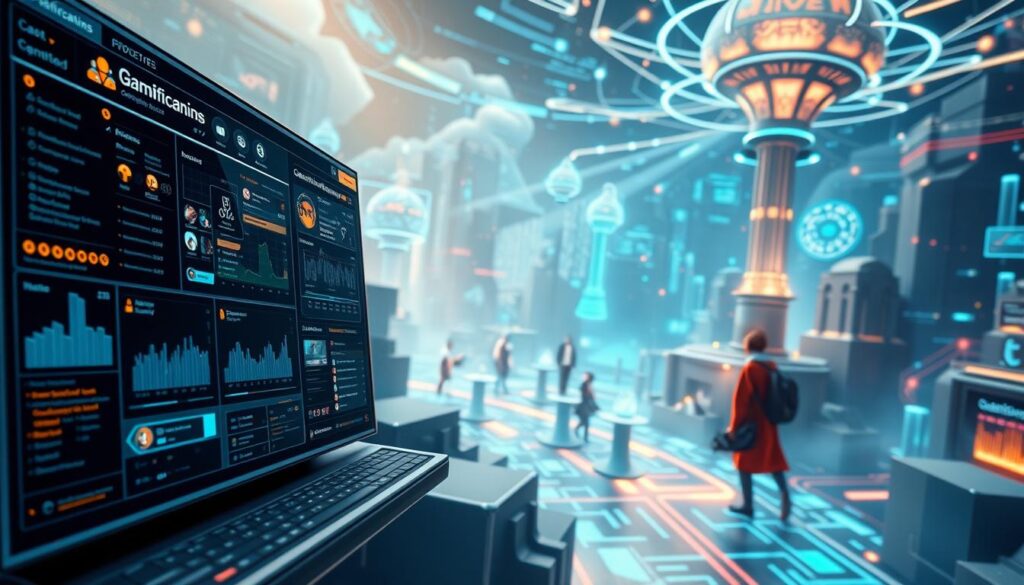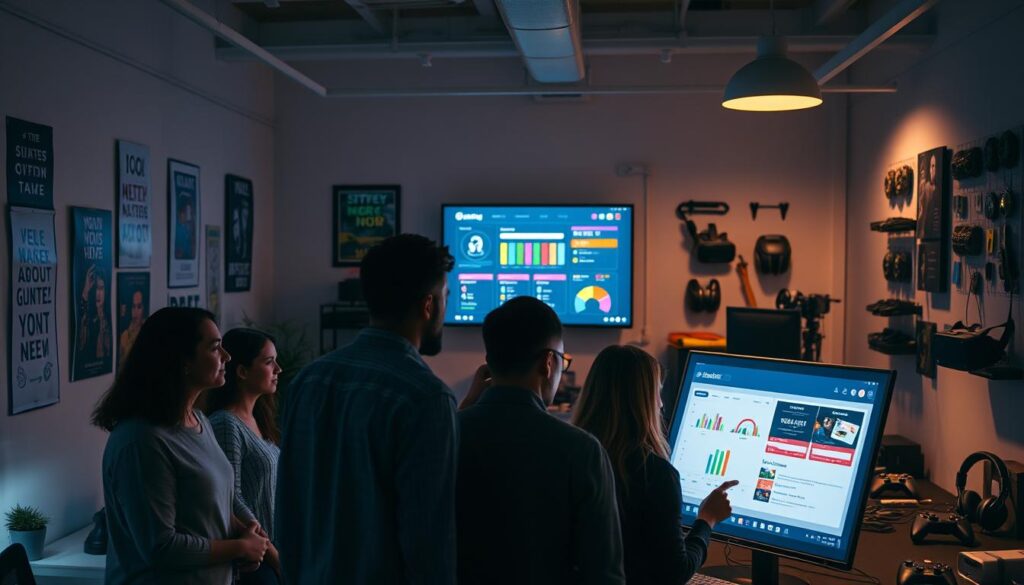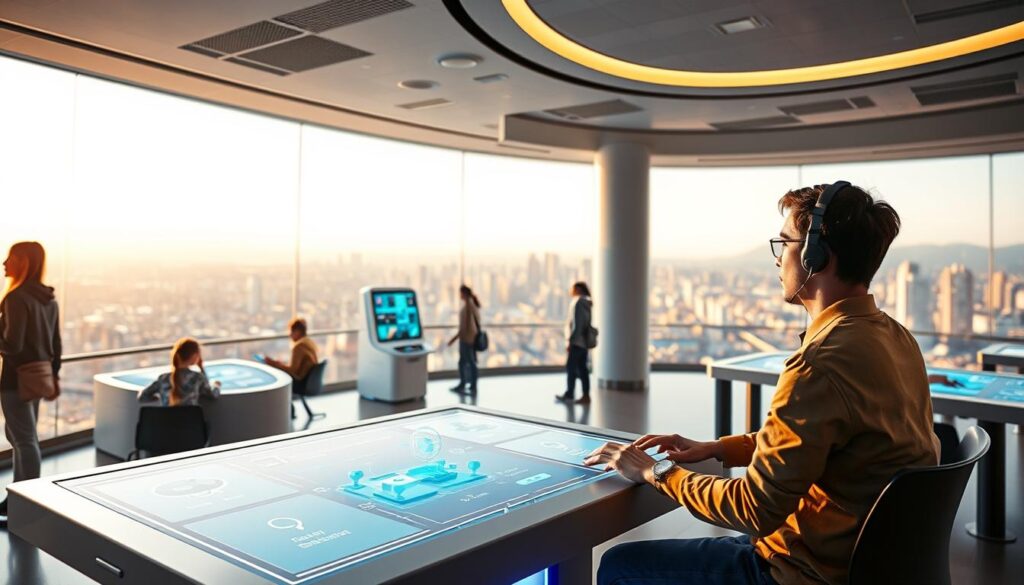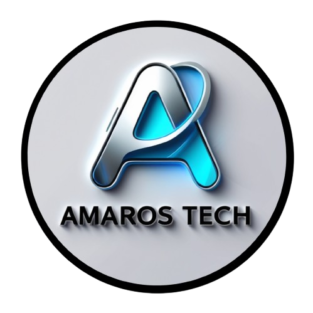
Businesses are turning to gamification to boost performance and engagement. By 2025, the global market is expected to hit $30.7 billion, growing at a 27.4% annual rate. Companies like Spinify and Domino’s have already seen major wins—sales teams become more productive, and training apps lift revenue by 30%.
What makes this approach so effective? Interactive elements like points, leaderboards, and rewards tap into natural human motivation. Studies show that 85% of employees engage more when their work includes game-like features. Emerging tech, such as AI personalization and AR/VR, will push these strategies even further.
However, ethical concerns around data and incentives must be addressed. As we explore actionable methods for sales, marketing, and HR, balancing innovation with responsibility will be key.
Key Takeaways
- The gamification market is projected to reach $30.7 billion by 2025.
- Businesses like Domino’s have increased sales by 30% using game-based training.
- 85% of employees show higher engagement with gamified systems.
- AI and AR/VR are shaping the next wave of interactive strategies.
- Ethical considerations are critical for sustainable implementation.
Why Creating Engaging Online Gamification That Generates Revenue in 2025 Matters
Gamification is reshaping industries by turning everyday tasks into rewarding experiences. It’s not just about points or badges—it’s a powerful tool to motivate teams and customers alike. By blending game mechanics with real-world goals, companies unlock higher productivity and loyalty.
The Rise of Gamification in Business
Over 70% of Global 2000 companies now use gamified systems. Brands like L’Oréal saw a 40% boost in engagement after launching a mobile app for travel retail staff. Microsoft took it further, linking charity donations to employee feedback—resulting in 16x more participation.
Even the US Army redesigned recruitment with gamified platforms, improving youth perception by 30%. These examples prove that game-like strategies work across sectors.
Projected Market Growth and Opportunities
The global market will hit $30.7 billion by 2025, growing at 27.4% annually. Regions like Africa are surging (60.1% CAGR), while APAC leads in adoption speed. SMEs are also jumping in, using social media challenges to compete with giants.
| Region | Growth Rate (CAGR) | Key Players |
|---|---|---|
| North America | 25.8% | Oracle, IBM |
| APAC | 29.3% | FreshDesk, local startups |
| Africa | 60.1% | Mobile-first solutions |
VR training simulations are another frontier. They cut operational risks in fields like manufacturing, showing how gamification evolves beyond screens.
Understanding Gamification: Core Concepts and Mechanics
Understanding gamification starts with its building blocks: points, badges, and leaderboards. These elements turn routine tasks into dynamic experiences. At its heart, gamification applies game design principles to non-game contexts, boosting motivation and results.
Defining Gamification and Its Key Elements
Gamification isn’t just games—it’s a strategy. It uses rewards, competition, and progress tracking to engage users. The Octalysis Framework breaks this into eight drives, like epic meaning (intrinsic) and bonuses (extrinsic).
For example, Nike Run Club awards badges for milestones, blending fitness with achievement. Recyclebank uses points to encourage eco-friendly habits. Both tap into core human desires.
Points, Badges, and Leaderboards: The Foundational Trio
These three mechanics are the backbone of gamified systems:
- Points: Quantify progress (e.g., Myntra’s app drove 650K+ interactions).
- Badges: Symbolize achievements (Nike’s fitness milestones).
- Leaderboards: Foster competition (Spinify boosted sales team participation by 40%).
| Motivator Type | Example | Industry Impact |
|---|---|---|
| Intrinsic | Epic meaning (Growth Engineering) | Learning pathways |
| Extrinsic | Cash bonuses | Retail sales spikes |
While effective, overusing basic PBL systems can backfire. Customization, like military training simulations, ensures relevance. The key? Balance simplicity with depth.
The Psychology Behind Successful Gamification
Human psychology drives the success of gamified systems, blending rewards with deep-rooted motivations. Studies show 72% of workers feel more driven when tasks include game-like elements. This isn’t luck—it’s design.

Intrinsic vs. Extrinsic Motivation
Citibank’s fitness program nails both motivation types. Employees earn cash bonuses (extrinsic) while building healthier habits (intrinsic). Toyota took a different route, using energy-saving challenges to tap into employees’ pride—a purely intrinsic driver.
Scripps Research Institute’s Dizeez app proves even data cataloging can excite. Scientists earn badges for contributions, merging purpose with recognition. The lesson? Balance is key. Overusing cash rewards can backfire, as Deloitte found in millennial stress studies.
How Positive Reinforcement Drives Behavior
L’Oréal’s BA training uses real-time feedback to reinforce skills. Immediate praise or corrections create a loop—act, learn, improve. Dunkin’ Donuts’ On Your Mark app gamifies customer data collection, offering points for surveys. Result? A 150% spike in interactions.
Team-based rewards, like Spinify’s sales leaderboards, foster camaraderie. But individual milestones matter too. Tracking progress visually—like Nike’s run maps—fuels persistence. The trick? Align mechanics with human instincts, not just metrics.
Top Gamification Strategies to Boost Revenue in 2025
Companies are adopting game-inspired tactics to drive measurable results. Research shows these strategies can lift productivity by 54% for new hires and increase sales by 22%. The secret lies in three core approaches that align with human motivation.
Leaderboards Fuel Healthy Competition
Salesforce integrates real-time leaderboards directly into CRMs, creating visible performance metrics. Spinify data reveals this approach boosts sales team output by 22%. The key is transparency—everyone sees rankings but can also track personal growth.
Effective leaderboards need:
- Weekly resets to give trailing players fresh starts
- Multiple categories (sales, customer satisfaction, etc.)
- Non-monetary recognition like “Rookie of the Month”
Missions Create Short-Term Wins
Domino’s Pizza Hero app transformed training into a series of challenges. Employees complete missions like perfect dough-tossing to unlock new levels. Amazon warehouses use similar timed tasks to maintain peak efficiency during shifts.
| Company | Challenge Type | Result |
|---|---|---|
| Coca-Cola | Beat the Boss sales contests | 17% higher close rates |
| Walmart | Inventory accuracy games | 40% fewer errors |
Reward Systems That Resonate
B2B programs often use professional development incentives, while B2C leans toward instant gratification. Metaverse platforms now offer tokenized crypto rewards, appealing to digital-native teams.
Customization matters:
- Gen Z prefers experience-based rewards
- Millennials value flexible time-off bonuses
- Boomer teams respond to public recognition
Avoid one-size-fits-all designs. What motivates warehouse staff differs from creative teams. Test different strategies and measure engagement before full rollout.
Gamification in Sales: Transforming Performance Metrics
Sales teams thrive on motivation and measurable results. Adding game mechanics to sales processes has proven to cut cycle times by 15-25% while boosting close rates. FreshDesk saw revenue jump 1,000% after implementing these strategies. The secret? Turning daily tasks into engaging challenges.
Case Study: Powering Productivity Through Play
HubSpot’s deal-closing dashboards show how gamification works. Reps earn badges for hitting milestones, while leaderboards highlight top performers. This approach reduced onboarding time by 30% for new hires.
ZoomInfo took it further with lead gen challenges. Teams compete in weekly sprints, with bonuses for quality contacts. The result? A 22% increase in qualified pipeline.
CRM Integration: Real-Time Feedback for Better Results
Modern CRMs like Salesforce now include built-in gamification tools. Spinify’s integration with Microsoft Teams gives instant visibility into:
- Deal progress
- Call metrics
- Team rankings
Medtronic’s surgical sales training uses VR simulations. Reps practice complex pitches in risk-free environments. This cut training costs by 40% while improving retention.
| Tool | Feature | Impact |
|---|---|---|
| Gong | Conversation analytics | 18% higher win rates |
| Spinify | Real-time leaderboards | 27% more calls made |
While competition drives performance, balance is key. Unhealthy rivalries can backfire. GDPR-compliant tracking ensures data stays secure while keeping teams motivated.
Looking ahead, AI coaching bots will personalize feedback. These tools analyze calls and suggest improvements, making every rep their best.
Gamifying Marketing Campaigns for Customer Engagement
Marketing teams are tapping into game mechanics to transform customer interactions. Myntra’s app proves this works—650K+ engagements came from features like style quizzes and limited-time challenges. By 2025, 93% of marketers will use these strategies, blending fun with measurable results.

Retail Success Stories
Sephora’s Color Match AR quiz boosted conversions by 35%. Customers scan their faces to find perfect makeup shades, turning browsing into play. Starbucks’ Summer Game takes loyalty further—members unlock tiers by completing purchases or social media tasks.
Nike’s SNKRS app uses shock drops for exclusivity. Sneaker releases become timed events with countdowns and early access codes. Like Duolingo’s language model, it rewards consistent engagement with rare perks.
Interactive Content That Converts
Burger King’s Burn That Ad campaign used AR to let users “torch” competitors’ ads for coupons. This drove a 56% redemption rate. TikTok’s hashtag challenges work similarly—user-generated content spreads brand messages organically.
- Patreon’s tiered rewards: Fans unlock content based on subscription levels
- TikTok’s gamified filters: Brands like Elf Cosmetics saw 3M+ challenge entries
But balance is crucial. Perpetual campaigns risk prize fatigue—Patreon creators rotate rewards to keep fans invested. The best strategies blend novelty with genuine value.
Gamification in HR: Enhancing Employee Training and Retention
HR departments are revolutionizing training with game-inspired techniques. Studies show gamified onboarding increases retention by 40%, while Microsoft’s charity-linked program boosted feedback participation 16-fold. These systems turn routine processes into engaging learning journeys that employees actually enjoy.
Onboarding New Hires With Gamified Modules
Deloitte’s leadership simulations set the standard. New managers navigate virtual scenarios where decisions impact simulated teams. Immediate scoring shows consequences—a powerful learning tool. Hilton takes a different approach with hotel management quests. Trainees earn badges for mastering housekeeping protocols or front-desk systems.
PwC’s Multipoly tax training game reduced errors by 29%. New accountants solve puzzles based on real tax codes. Unilever even uses AI-powered hiring assessments that adapt to candidate responses, making evaluations feel like strategy games rather than tests.
Team-Based Challenges to Foster Collaboration
Google’s Code Jam proves competition works when balanced. Engineers solve problems in timed sprints, but final rankings highlight team contributions over individual stars. Boeing’s VR maintenance training takes this further—technicians collaborate in virtual hangars to troubleshoot jet engines.
Effective programs share three traits:
- Clear progression paths (like Hilton’s badge tiers)
- Mixed challenges (individual tasks + group objectives)
- Transparent scoring (PwC’s real-time tax accuracy metrics)
But warning lights flash when rivalry overshadows growth. Salesforce found excessive leaderboard pressure decreased performance by 12% in some departments. The sweet spot? Friendly competition that celebrates collective wins while recognizing personal growth.
The Role of AI in Future Gamification Design
AI is reshaping gamification by blending smart automation with human psychology. With 74% of consumers demanding personalized experiences, tools like ChatGPT now craft challenges that adapt in real time. But the real magic happens when machines enhance—not replace—human creativity.
Balancing Automation with Human-Centric Design
Salesforce Einstein’s predictive coaching shows how AI excels. It analyzes sales calls to suggest improvements, but reps still drive the conversation. Similarly, Woebot’s mental health check-ins use AI to guide users—while keeping empathy central.
Unity’s AI playtesting tools reveal another layer. They simulate thousands of player reactions to refine mechanics. Yet, narrative design thrives on human intuition. As one developer noted: *”Algorithms optimize fun, but stories need soul.”*
Risks of Over-Relying on AI-Generated Mechanics
Dynamic Yield’s reward algorithms boost engagement—yet studies warn of a 22% drop in intrinsic motivation when automation dominates. HR systems face bigger pitfalls. Amazon’s biased hiring tool proved AI can reinforce inequities if unchecked.
- Ethical gaps: 2025’s AI regulations will demand transparency in data usage.
- Creative limits: Over-optimized challenges feel sterile (e.g., Duolingo’s repetitive drills).
The future? Hybrid strategies. Let AI handle scalability, but keep human judgment at the core. After all, the best games—and work—are those that inspire, not just instruct.
Personalization: The Key to Modern Gamification
Personalized experiences are no longer optional—they’re expected. A staggering 94% of businesses now consider customization critical for engagement. From Spotify Wrapped-style performance reviews to role-based simulations, tailored approaches drive 35% higher completion rates.

Meeting Millennial Workforce Expectations
Deloitte’s research reveals 80% of millennial workers prefer systems adapting to their needs. Accenture’s skills gap games demonstrate this—employees choose development paths matching career goals. Adobe’s Creative Cloud takes it further, awarding badges for mastered skills.
“Young professionals expect work tools to mirror consumer app experiences—intuitive, rewarding, and uniquely relevant.”
| Generation | Preferred Motivation | Example |
|---|---|---|
| Millennials | Career-aligned growth | SAP’s simulation modules |
| Gen Z | Social recognition | Slack achievement sharing |
| Gen X | Time efficiency | Quick reference microlearning |
Building Adaptive Learning Pathways
Growth Engineering’s Netflix-style learning systems adjust content based on user progress. SAP’s manufacturing simulations change scenarios depending on role—technicians versus managers. This personalization reduces training time by 28%.
Data privacy remains crucial. Systems like PwC’s Multipoly anonymize performance metrics while delivering individualized feedback. The next frontier? AR glasses projecting contextual tips during tasks—merging real-world experiences with digital guidance.
Social Media and Gamification: A Powerful Duo
Social media platforms have become playgrounds for gamified experiences. Brands now leverage game mechanics to boost engagement by 100-150%, turning casual users into active participants. With a 32% annual rise in social gamers, these strategies are reshaping digital interactions.
How Brands Master Gamified Campaigns
Reddit’s Award system shows the power of micro-rewards. Users give tokens to highlight standout comments, creating a community-driven economy. Wendy’s turned Twitter roasts into a game—followers earned clout by joining witty exchanges.
LinkedIn Skill Assessments take it professional. Earned badges showcase expertise, while Instagram’s Collab feature lets brands co-create challenges with influencers. Duolingo’s TikTok presence proves even education can trend—their owl mascot became a viral meme.
The Science Behind Dopamine-Driven Engagement
Twitter’s Community Notes gamifies fact-checking. Users earn trust scores for accurate contributions. But risks exist—addictive designs can exploit psychological triggers. Meta’s metaverse plans hint at future UGC contests where virtual items hold real value.
- Balanced design: Reward without manipulation
- Transparency: Clear rules for participation
- Community focus: Shared goals over solo wins
As platforms evolve, ethical frameworks must keep pace. The best campaigns merge fun with genuine value—proving games and social media are natural allies.
Gamification Tools to Elevate Your Strategy
The right platform can turn basic game mechanics into powerful business results. With 60% of tools now offering AI analytics, choosing wisely impacts everything from sales cycles to training outcomes. Let’s explore top solutions and future-ready features.
Comparing Leading Gamification Platforms
Spinify stands out for sales teams, cutting deal cycles by 22% with real-time leaderboards. Salesforce integrates natively with CRMs, while HubSpot focuses on marketing automation. For enterprises, Bunchball Nitro offers deep customization—L’Oréal used it to boost retail staff engagement by 40%.
TalentLMS shines for training, with course builder integrations that reduced Unilever’s onboarding time by 30%. LevelEleven takes a CRM-specific approach, perfect for teams using Microsoft Dynamics. Key differences:
- Spinify: Best for sales performance tracking
- Salesforce: Ideal for existing ecosystem users
- Bunchball: Top choice for complex enterprise needs
Must-Have Features for 2025
Next-gen tools will need AR integration—Walmart’s VR stockroom training cut errors by 40%. Crypto rewards are rising too, with metaverse platforms like Decentraland offering tokenized incentives.
Three critical capabilities:
- GDPR-compliant data tracking
- No-code customization for SMBs
- AI-driven personalization engines
Pricing varies widely. Spinify starts at $15/user monthly, while Bunchball’s enterprise packages exceed $50K annually. For startups, no-code builders like Gamify offer affordable entry points under $500/month.
“The best platform aligns with your team’s workflow, not the other way around.”
As strategies evolve, so must your tech stack. Prioritize flexibility—today’s badge system might need tomorrow’s AR overlay.
Measuring the Success of Your Gamification Efforts
Data-driven insights transform gamification from guesswork to precision strategy. While 41% of companies report reduced training gaps with analytics, 63% fail by neglecting measurement. Lasting success requires tracking both numbers and human behaviors.
Essential Metrics That Reveal Real Impact
L’Oréal’s beauty advisor program tracks three core KPIs:
- Daily Active Users (DAU) showing consistent engagement
- Revenue per trained employee (+28% post-implementation)
- Customer satisfaction scores tied to challenge completion
MIT’s ROI framework proves effective programs measure:
| Metric Type | Example | Optimal Frequency |
|---|---|---|
| Quantitative | Completion rates | Weekly |
| Qualitative | Employee feedback | Monthly |
“The best predictors of long-term success blend participation data with cultural adoption metrics.”
Turning Data Into Actionable Improvements
A/B testing different reward structures helped Domino’s boost pizza-making accuracy by 19%. Key analysis steps:
- Segment users by engagement levels
- Compare progress across challenge types
- Model attrition risks using completion patterns
Warning: Vanity metrics like total badges earned often mislead. Focus instead on behavioral shifts—Walmart found stockroom errors dropped 40% only when tracking corrected actions, not just participation.
Ethical Considerations in Gamification Design
Ethical boundaries in gamification aren’t just guidelines—they’re the foundation of sustainable engagement. With 88% of users demanding clarity on data usage, and EU GDPR fines surpassing €4B last year, cutting corners carries real consequences. The most effective systems balance motivation with respect for user autonomy.
Transparency as the Cornerstone of Trust
Apple’s App Tracking Transparency framework rewrote the rules overnight. Apps now must justify data collection, mirroring broader expectations. Three critical areas need clarity:
- Data usage: Loot box regulations show the risks of opaque mechanics
- Reward structures: Epic Games’ lawsuits highlight “dark pattern” pitfalls
- Age gates: WHO’s gaming disorder classifications inform youth protections
PwC’s ethical reward design offers a model. Their tax training game discloses scoring algorithms upfront, building participant trust while maintaining challenge.
Designing Without Manipulation
Avatar creation tools reveal unconscious biases. When SAP analyzed their simulation characters, they found:
| Issue | Solution |
|---|---|
| Gender stereotypes | Neutral role options |
| Cultural insensitivity | Localized scenarios |
The metaverse amplifies these challenges. Decentraland’s community standards prohibit exploitative mechanics, while still allowing competitive events. As global ethics standards emerge in 2025, proactive companies will lead the conversation—not scramble to comply.
“Good gamification respects the player’s mind, not just their metrics.”
Emerging Trends: AR, VR, and the Metaverse
Immersive technologies are redefining engagement across industries. By 2025, AR and VR will power 30% of corporate training programs, while the metaverse becomes a $800B market. These tools merge physical and digital worlds, creating unforgettable experiences.
Augmented Reality’s Practical Applications
IKEA Place’s AR app lets users visualize furniture at home, boosting conversions by 34%. Retailers like Sephora follow suit with virtual try-ons. But it’s not just shopping—field technicians use AR glasses for real-time repair guides, cutting service calls by 25%.
Key sectors adopting AR:
- Healthcare: Surgeons overlay 3D scans during operations
- Education: Interactive textbook annotations
- Manufacturing: BMW’s metaverse showrooms reduce prototyping costs
Why VR Excels in High-Risk Training Simulations
Boeing’s VR assembly training slashed aircraft errors by 40%. Unlike classrooms, VR replicates dangerous scenarios safely. Walmart trains 1M+ employees annually in virtual compliance modules—resulting in 70% faster recall than manuals.
“VR isn’t just realistic—it’s risk-free. Trainees can fail without real-world consequences.”
Costs are dropping too. Pico headsets now cost under $400, while Unity’s tools let SMEs build custom simulations. With 5G reducing latency, mobile VR adoption will surge—especially for Apple Vision Pro’s enterprise apps.
| Technology | ROI Example | Adoption Barrier |
|---|---|---|
| AR | 34% higher retail sales | Device dependency |
| VR | 40% fewer assembly errors | Initial hardware cost |
Cryptocurrency and Gamification: Future Synergies
Blockchain-powered rewards are rewriting the rules of engagement in digital ecosystems. Axie Infinity proved this potential, with peak daily revenues hitting $17.5M through its play-to-earn model. As 61% of gamers now prefer crypto payment options, these systems are moving beyond niche markets.

Tokenized Rewards Reshaping Participation
STEPN’s move-to-earn app demonstrates how physical activity can generate tangible crypto value. Users earn GST tokens for walking—blending health goals with financial incentives. Similarly, Starbucks Odyssey integrates Polygon-based stamps into its loyalty program, creating collectible digital assets.
Key lessons from thriving models:
- Fortnite’s V-Bucks: Showcased scalable virtual currencies (3B+ transactions annually)
- Decentraland: Hosted 300+ virtual events in 2023, powered by MANA tokens
- NFT achievements: Gitcoin uses verifiable credentials for developer contributions
Navigating New Frontiers
Regulatory hurdles remain significant. The SEC’s scrutiny of Axie’s AXS token highlights compliance challenges in play-to-earn systems. Environmental concerns also persist—Ethereum’s shift to proof-of-stake reduced energy consumption by 99.95%, setting a precedent.
| Challenge | Innovation |
|---|---|
| Regulation | CBDC integrations (Bahamas Sand Dollar loyalty trials) |
| Sustainability | Tezos’ low-energy NFT platforms |
The future points toward hybrid models. As Visa tests crypto-backed debit rewards, traditional finance merges with gamification. What began as pixelated points now represents a fundamental shift in value exchange—one where participation builds tangible equity.
Conclusion
The future of interactive business strategies is here, blending innovation with proven results. AI-driven personalization and AR/VR integration will redefine how teams and customers interact by 2025.
Ethical design remains critical. Companies that prioritize transparency in gamification see 40% higher long-term engagement. From healthcare simulations to retail loyalty programs, these approaches now span every sector.
Effective strategies require continuous measurement. Track both participation metrics and behavioral changes to ensure real impact. Test emerging tools cautiously—neural interfaces may soon join the toolkit.
Now is the time to act. Start small, measure often, and scale what works. Sustainable success comes from balancing creativity with data-driven decisions.
